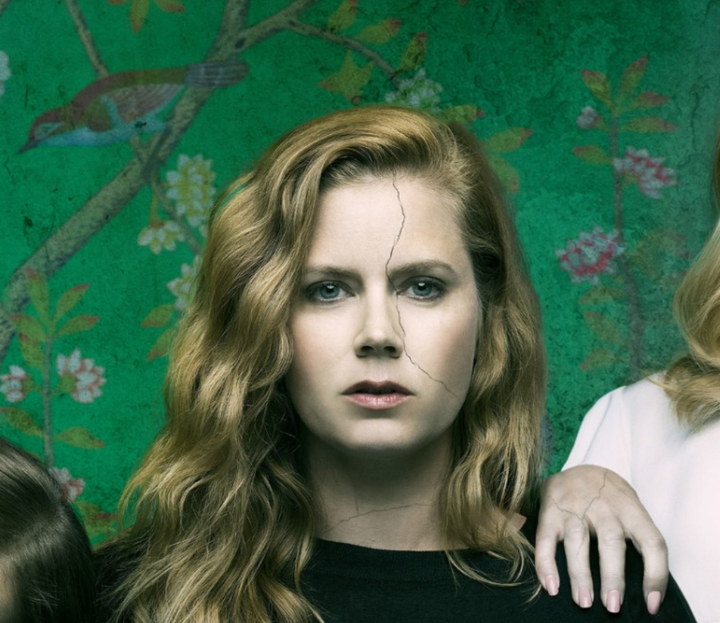
Camille Preaker, the antihero of “Sharp Objects,” HBO’s slow-burn, Ozark Gothic thriller, is an undeniably awful journalist. (Warning: Spoilers below.)
She forgets to take notes and record interviews. She doesn’t clarify when sources are on and off the record. She’s usually trashed. She violates ethical norms, most notably, hooking up with her sources. (She gets together with the detective and the 18-year-old murder suspect. At least she gets both sides of the story?) She’s one of a long line of on-screen portrayals who make real-life women journalists look terrible. And she really shouldn’t be covering murder cases in which her family is directly involved.
So why do I still like her?
Throughout the season ― the finale aired Sunday ― Camille never fit neatly into the usual tropes forced upon on-screen lady reporters. Her job was not a means to a romantic plot, nor a symbol of ugly ambition. And while “Sharp Objects” didn’t hesitate to judge Camille’s behavior, it was careful to show the unflattering parts of her in the light of her trauma ― the show’s real subject.
There’s a scene early in the season I haven’t been able to stop thinking about. Camille (played by Amy Adams) is interviewing a father, a possible suspect. The father is defensive, the conversation heated. Camille’s well-coiffed mother, Adora (Patricia Clarkson), bursts into the room, all Tennessee Williams by way of Lilly Pulitzer. “How dare you interrogate him,” she hisses. “You are not to harass good people.” She adds, “Your presence here is inappropriate.”
Mom: the ultimate flack.
It would have been easy for the show to use this scene to frame Camille as pushy or out of line. To paint journalism as a job nice girls don’t do. Instead, the unflattering behavior in this scene is all Adora’s. She is the inappropriate one. You feel Camille’s frustration as she packs up her recorder and screams in her car. She knows that respectfully bothering the community to get information is the job — it’s her overbearing mother who doesn’t get it.
By the end of the season, Adora is practically trolling Camille. “Your editor must be excited about getting his intrepid girl reporter back. What will you work on next? Maybe something more upbeat for a change,” she says, suggesting that Camille should go ahead and ignore the fact that Adora is poisoning her daughters.
The premise of “Sharp Objects” is that Camille’s way too emotionally involved editor-therapist, Frank Curry (Miguel Sandoval), sends her back to her ghostly hometown of Wind Gap, Missouri, to report on a possible killer of teenage girls. Curry seems to think that this story might help Camille — who lost her sister, engages in self-harm and is an alcoholic — work through some of her shit. The action moves very slowly, and there is a lot of Led Zeppelin.
But along the way, the show also reveals some messy truths about journalism: Sometimes the job looks a bit like harassment. Sometimes you’re trespassing from a position of privilege on the most vulnerable and traumatic parts of people’s lives. Sometimes you’re bouncing between lonely motels, cars and bars. Sometimes you’re not a perfect recorder-robot and your personal experiences impact your work. Sometimes the work becomes entangled in your personal experiences in ways your journalism school would not approve of. And sometimes you need to take care of yourself and your own mental health before you can effectively help tell other people’s stories.
When I initially started the show ― I haven’t read the Gillian Flynn book it is based on ― I found the human portrayal of Camille refreshing. Real-life journalists do grapple with trauma and abuse as part of their jobs, and we don’t always talk about what that looks like. Additionally, there are so few relatable journalism moments in popular culture, fewer still involving female journalists.
Until now, I have only two favorites, and not because they are good.
The first is when Zoolander lectures an enterprising Time magazine reporter:
The world does not revolve around you and your do whatever it takes, ruin as many people’s lives, so long as you can make a name for yourself as an investigatory journalist, no matter how many friends you lose or people you leave dead and bloodied along the way, just so long so you can make a name for yourself as an investigatory journalist.
The second is in the indie movie “Safety Not Guaranteed,” when a grouchy intern (played by Aubrey Plaza at her very Aubriest) disappears on a time travel machine.
Other than that, my choice of on-screen lady reporters has been slim. On one side, we’ve got Maggie Haberman in the documentary “The Fourth Estate” and Sacha Pfeiffer (played by Rachel McAdams) in “Spotlight,” who are great and aspirational figures. On the other side, we have roughly 1 billion lady reporters Hollywood has decided must sleep with their bosses and/or sources.
Of the latter, there seem to be two vague subcategories:
In rom-coms, women get to be journalists in order to end up with a man, as my colleague Chloe Angyal so delightfully detailed. In “Trainwreck,” Amy Schumer falls in love with a guy she’s writing about for a men’s magazine. In “How to Lose A Guy in 10 Days,” Kate Hudson falls in love with a guy she’s writing about for a women’s magazine. (He also stops her on the way to her interview for a new job to make out.) In “Never Been Kissed,” Drew Barrymore goes undercover at a school to ultimately make out with a teacher. The job is a means to romantic fulfillment.
In more serious dramas, women get to be “slutty ambition monsters.” Exhibit A: Kate Mara in “House of Cards,” who sleeps with Kevin Spacey and then is hit by a train. The job is an instrument of unflattering ambition, and comeuppance is close at hand.
My colleagues have already explained extensively why this false stereotype is so harmful to female reporters. It suggests we don’t take ethics seriously, don’t earn our stories and positions rightfully. It’s particularly gross in this Me Too moment, when numerous women reporters have spoken out about being sexually harassed on the job, and when women are routinely breaking stories of enormous consequence about the behavior of powerful men. Maybe in an era in which trust in media is eroding and women reporters routinely face sexist and racist threats, it’s time for Hollywood to stop leaning into the reliable old stereotypes.
So with that in mind, I was really rooting for Camille. Then, she started sleeping with her sources. First, she pursued romance (um, power-fingering) with Detective Richard Willis (Chris Messina). Next — while I screamed at the television: NO, YOU ARE RUINING MY STORY — she hooked up with the teenage murder suspect, John Keene (Taylor John Smith). From a journalism ethics standpoint, both of these relationships are a disaster. Full stop.
Still, with due respect to The Atlantic’s Sophie Gilbert, who recently inveighed against the “trope of the unethical female journalist,” I think “Sharp Objects” is up to something a little different here. Camille’s ethical missteps don’t fit into either the lovestruck rom-com heroine or ambition-monster stereotypes. Just when you think she might be on her way to holding hands with Willis, he finds her in bed with Keene and calls her a slut — a moment that puts its misogyny on the surface. Later, her relationship with Willis culminates only in a mutual apology.
Likewise, her involvement with Keene isn’t about romance; it’s about communing over the deaths of both of their sisters. And though Camille is sort of interviewing both men, I wouldn’t say she’s primarily motivated by her work. She’s just trying to get through the day and onto her next bottle of vodka.
Camille’s short-lived triumph at the end of the season appears to be writing a story her editor, Curry, calls “beautiful,” before telling her to just file it. (Reason No. 135 Curry is not a real editor.) But the story — which would, presumably, fail journalistically, given Camille hasn’t yet seen the dollhouse teeth floor — is not treated as a professional triumph so much as a personal one.
“You noticed, I finally stopped asking if you were fine?” Curry says.
Camille responds, “You notice I started asking if you were?”
Ultimately, “Sharp Objects” is about a woman working through trauma. The job is not for love or personal enrichment. It’s a way of addressing the monsters without and within, a way of being in the world ― a sentiment that even the most tough-minded journalists won’t find too unfamiliar.
